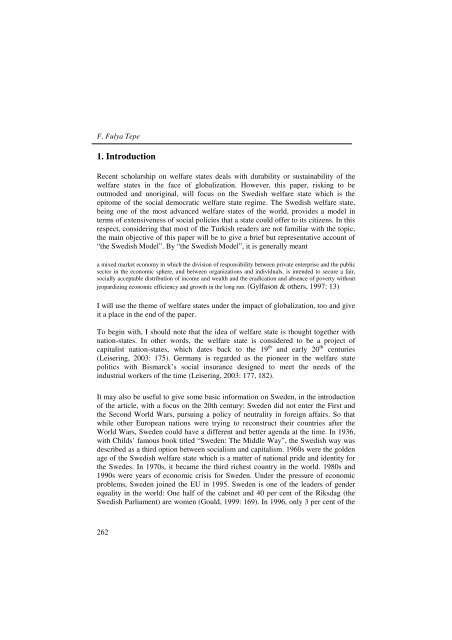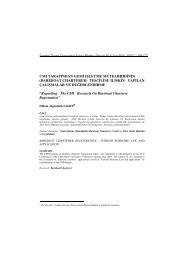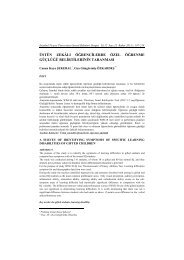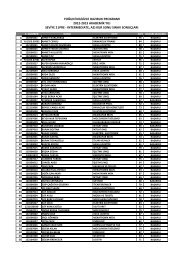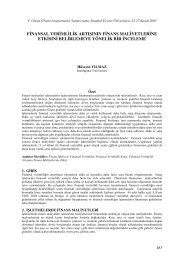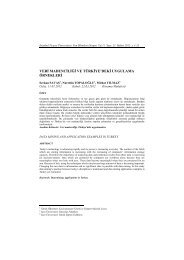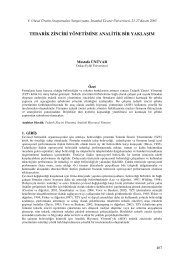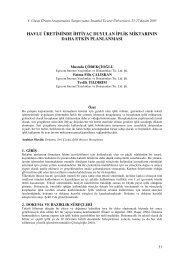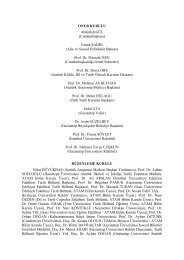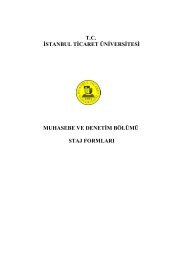an introduction to the swedish welfare state - Ä°stanbul Ticaret ...
an introduction to the swedish welfare state - Ä°stanbul Ticaret ...
an introduction to the swedish welfare state - Ä°stanbul Ticaret ...
Create successful ePaper yourself
Turn your PDF publications into a flip-book with our unique Google optimized e-Paper software.
F. Fulya Tepe1. IntroductionRecent scholarship on <strong>welfare</strong> <strong>state</strong>s deals with durability or sustainability of <strong>the</strong><strong>welfare</strong> <strong>state</strong>s in <strong>the</strong> face of globalization. However, this paper, risking <strong>to</strong> beoutmoded <strong>an</strong>d unoriginal, will focus on <strong>the</strong> Swedish <strong>welfare</strong> <strong>state</strong> which is <strong>the</strong>epi<strong>to</strong>me of <strong>the</strong> social democratic <strong>welfare</strong> <strong>state</strong> regime. The Swedish <strong>welfare</strong> <strong>state</strong>,being one of <strong>the</strong> most adv<strong>an</strong>ced <strong>welfare</strong> <strong>state</strong>s of <strong>the</strong> world, provides a model interms of extensiveness of social policies that a <strong>state</strong> could offer <strong>to</strong> its citizens. In thisrespect, considering that most of <strong>the</strong> Turkish readers are not familiar with <strong>the</strong> <strong>to</strong>pic,<strong>the</strong> main objective of this paper will be <strong>to</strong> give a brief but representative account of“<strong>the</strong> Swedish Model”. By “<strong>the</strong> Swedish Model”, it is generally me<strong>an</strong>ta mixed market economy in which <strong>the</strong> division of responsibility between private enterprise <strong>an</strong>d <strong>the</strong> publicsec<strong>to</strong>r in <strong>the</strong> economic sphere, <strong>an</strong>d between org<strong>an</strong>izations <strong>an</strong>d individuals, is intended <strong>to</strong> secure a fair,socially acceptable distribution of income <strong>an</strong>d wealth <strong>an</strong>d <strong>the</strong> eradication <strong>an</strong>d absence of poverty withoutjeopardizing economic efficiency <strong>an</strong>d growth in <strong>the</strong> long run. (Gylfason & o<strong>the</strong>rs, 1997: 13)I will use <strong>the</strong> <strong>the</strong>me of <strong>welfare</strong> <strong>state</strong>s under <strong>the</strong> impact of globalization, <strong>to</strong>o <strong>an</strong>d giveit a place in <strong>the</strong> end of <strong>the</strong> paper.To begin with, I should note that <strong>the</strong> idea of <strong>welfare</strong> <strong>state</strong> is thought <strong>to</strong>ge<strong>the</strong>r withnation-<strong>state</strong>s. In o<strong>the</strong>r words, <strong>the</strong> <strong>welfare</strong> <strong>state</strong> is considered <strong>to</strong> be a project ofcapitalist nation-<strong>state</strong>s, which dates back <strong>to</strong> <strong>the</strong> 19 th <strong>an</strong>d early 20 th centuries(Leisering, 2003: 175). Germ<strong>an</strong>y is regarded as <strong>the</strong> pioneer in <strong>the</strong> <strong>welfare</strong> <strong>state</strong>politics with Bismarck’s social insur<strong>an</strong>ce designed <strong>to</strong> meet <strong>the</strong> needs of <strong>the</strong>industrial workers of <strong>the</strong> time (Leisering, 2003: 177, 182).It may also be useful <strong>to</strong> give some basic information on Sweden, in <strong>the</strong> <strong>introduction</strong>of <strong>the</strong> article, with a focus on <strong>the</strong> 20th century: Sweden did not enter <strong>the</strong> First <strong>an</strong>d<strong>the</strong> Second World Wars, pursuing a policy of neutrality in foreign affairs. So thatwhile o<strong>the</strong>r Europe<strong>an</strong> nations were trying <strong>to</strong> reconstruct <strong>the</strong>ir countries after <strong>the</strong>World Wars, Sweden could have a different <strong>an</strong>d better agenda at <strong>the</strong> time. In 1936,with Childs’ famous book titled “Sweden: The Middle Way”, <strong>the</strong> Swedish way wasdescribed as a third option between socialism <strong>an</strong>d capitalism. 1960s were <strong>the</strong> goldenage of <strong>the</strong> Swedish <strong>welfare</strong> <strong>state</strong> which is a matter of national pride <strong>an</strong>d identity for<strong>the</strong> Swedes. In 1970s, it became <strong>the</strong> third richest country in <strong>the</strong> world. 1980s <strong>an</strong>d1990s were years of economic crisis for Sweden. Under <strong>the</strong> pressure of economicproblems, Sweden joined <strong>the</strong> EU in 1995. Sweden is one of <strong>the</strong> leaders of genderequality in <strong>the</strong> world: One half of <strong>the</strong> cabinet <strong>an</strong>d 40 per cent of <strong>the</strong> Riksdag (<strong>the</strong>Swedish Parliament) are women (Gould, 1999: 169). In 1996, only 3 per cent of <strong>the</strong>262


